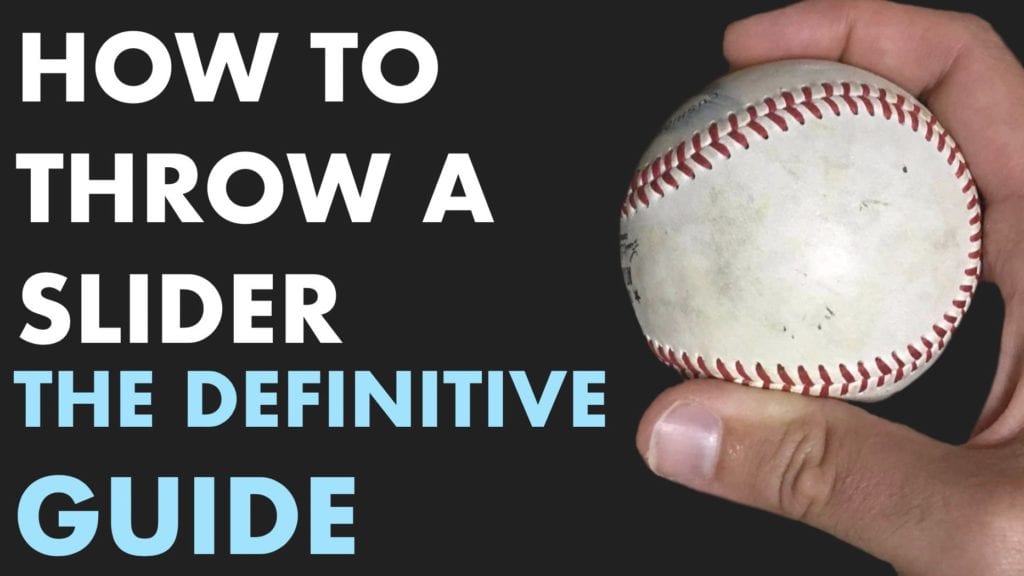*This article may contain product links which pay me a small commission if you make a purchase. Learn more.
Learning how to throw a slider is one of the more difficult tasks in baseball. The problem is that it’s not as straightforward a pitch as the curveball, and takes a lot more patience and a pitching coach who knows what he’s doing. In this article, you’ll learn slider grips, the spin, technique and troubleshooting to throw a slider.
Note: this article may contain affiliate links, which mean if you click them and buy a product, I may earn a small commission with no additional cost to you. This helps me continue to create more free content for you, and I only recommend products I know and use.
How to Throw a Slider – What’s In This Comprehensive Article
Here’s the overview of this definitive guide to throwing a slider. What we’ll cover today is important for pitchers of all ages:
- Slider grips
- The spin – how a slider breaks and why
- Common misconceptions
- What type of pitcher should throw a slider
- How hard to throw it
- Slider locations
- How to go about learning it–the process and pitching drill videos.

How Do You Grip a Slider?
To grip a slider properly, you need to place two fingers on the ball along the edge of one seam so the pitch can release from the finger tips with a combination of bullet spin and forward spin. But – here are things to understand about slider grips:
- The grip will NOT make the pitch
- Finding a good grip simply helps you spin the ball better
- A Major Leaguer’s grip may or may not work for you
- Tinker and give different grips a good, fair try before declaring them a success or failure
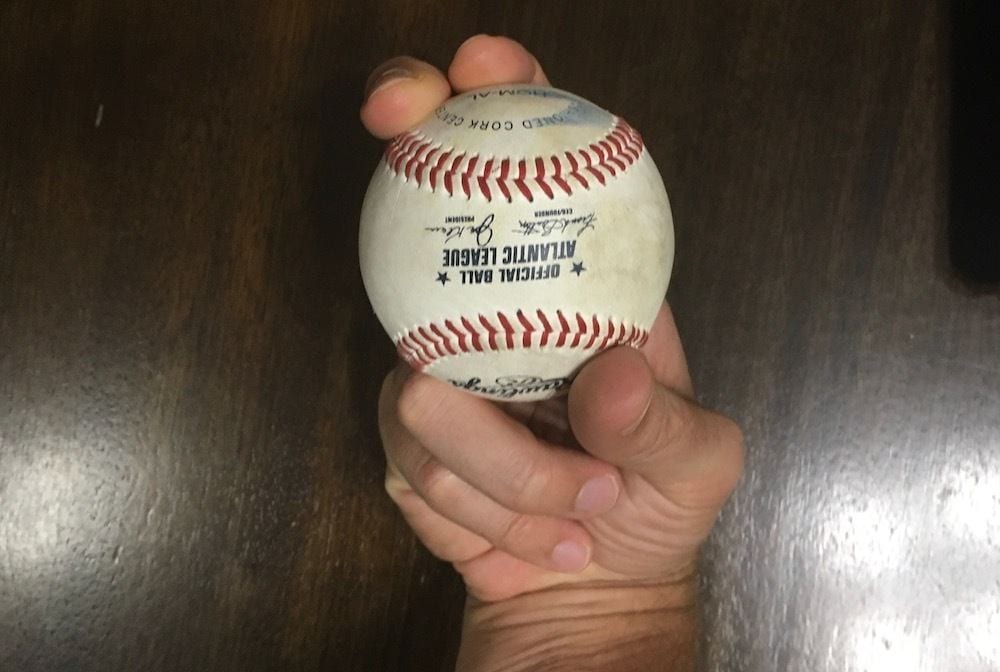
Different Slider Grips to Try
My video below (which is #1 if you search on YouTube for the slider) is the best way to learn about grips. Check it out and subscribe to my channel!
But, the basic grip looks something like the photo below, with index and middle finger next to each other, overloaded on the arm side of the ball and snaking up the horseshoe.
The Type of Spin You Want on a Slider
A slider is a combination of two spins: bullet spin and forward spin, which together make the ball break at an angle.
Bullet spin = spin perpendicular to the direction the ball is traveling.
Forward spin (topspin) the ball spins in the same direction the ball is traveling.
When thrown correctly, the ball produces a red dot on the forward aspect of the ball–hitters identify sliders by this dot but it’s just a part of the pitch and not something pitcher’s want to avoid. The dot is a sign of a well-thrown slider.
The way every pitcher’s slider breaks is unique, but the average is a diagonal break with mostly equal downward and lateral break.
To produce this type of break, basically the following happens:
- The pitcher tries to get his fingertips toward the front of the ball to produce forward spin. Thinking about being on top of it is a good mindset.
- Then, as he releases it, he’ll get slightly to the side of it and the natural pronation of his hand will apply the “bullet spin.”
What lots of pitchers do by accident–which is NOT correct–is they get way to the side of it, trying to impart the sideways sweeping action they see on TV by getting their hand around the ball.
Getting on the side of the ball produces a pitch with lots of sidespin, which causes sloppy, poor break.
Common Misconceptions About Throwing the Slider
Okay, let’s tackle some common misconceptions about throwing the slider:
- They’re more stressful on the arm
- They’re not appropriate for youth pitchers
- They’re more difficult to throw
- The curveball is a better pitch
- You throw a slider by getting on the side of it
Let’s do this!
Misconception #1 & 2: They’re more stressful and not appropriate for youngsters
First, I do agree that sliders aren’t best for young pitchers, but only on the grounds that ALL breaking balls should be taught later–at age 14 or 15.
That said, I don’t believe–and research corroborates this–that any type of breaking ball is worse than another. So if a kid is ready to learn a curveball, there’s no reason he couldn’t learn a slider instead. No evidence shows that sliders are worse than curveballs.
In fact, the American Sports Medicine Institute’s research has shown that the fastball is the most stressful pitch, in part because velocity is closely linked to arm stress. So, fastballs are more stressful than sliders.
BUT.
That’s not to say that breaking balls of any type are good for young pitchers (which I’ll define as pitchers age 14 and below).
Rather, I think breaking balls should be taught in the 14U season, and not relied upon until the 15U or 16U season. The reason? Because pitchers over-rely on breaking balls and don’t learn to command their fastball or develop a good changeup, both of which are very important long-term.
Are Sliders Okay For Amateur Pitchers?
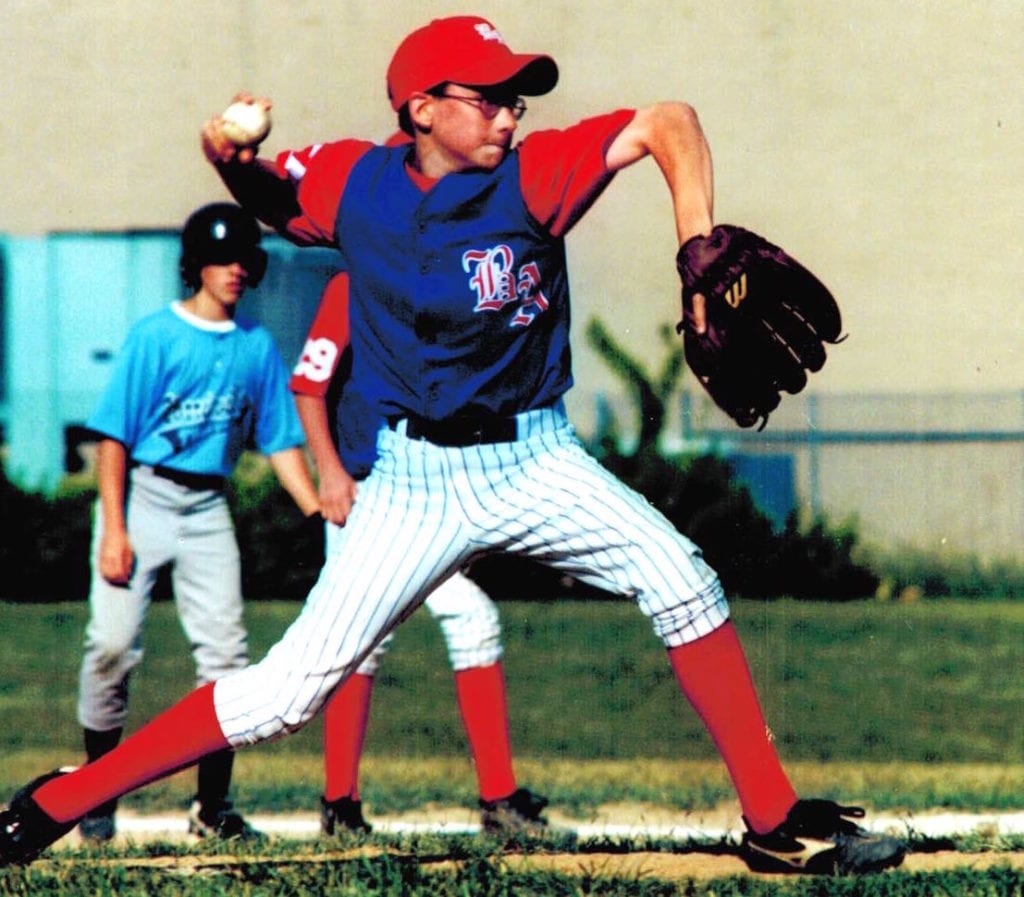
Yes, within reason. Pitchers should always learn to command their fastball and changeup first. Then, add a breaking ball in later.
If a pitcher is cleared to throw a curveball, then he’s fine throwing a slider. Really, it’s just about arm action and which pitch a pitcher is better suited for.
More on who is suited for a slider and who isn’t, in a bit.
Misconception #3: They’re More Difficult to Throw
Sliders are not more difficult to learn than curveballs–both pitches take a lot of dedication, time and good teaching to throw well.
Any kid can throw a bad curveball (and most curveballs are bad curveballs). Likewise, any kid can throw a poor slider.
Throwing a good one? The slider is probably easier, which is why so many more pitchers throw them at the collegiate and pro levels.
They’re easier to throw because the pitcher can go through the pitch a lot more–much more like a fastball–compared to a curveball. And, they’re easier to throw for strikes because their break is shorter. The slider can be “forced” into the zone a lot easier than the curveball.
Misconception #4: The Curveball Is a Better Pitch
Eh. I’m not sure either pitch is better. The curveball can be very difficult to hit when thrown well, but sliders are thrown harder and look like fastballs longer. Really it’s probably a push between the two, and it’s a bit of an apples to oranges comparison.
Watch the video below on the slider vs the curveball for more!
Ultimately, the best breaking ball is one that you can throw well. For some, that’s the curveball. For others, that’s the slider. It’s highly individual and not important which one a pitcher chooses. The only important thing is that a pitcher can throw one of them well.
Misconception #5: You Get on the Side of a Slider to Make it Break That Way
I touched on this earlier, and nope–we don’t want to impart sidespin and make it spin like a frisbee.
Rather, the pitch is a combination of a bullet and forward spin, so mentally trying to get *mostly on top of the pitch is the right mindset to have. Though the fingers won’t actually be on top of the ball, the goal is to avoid letting the hand slip way onto the side, which produces entirely wrong spin–frisbee spin is no bueno.
What Type of Pitcher Should Throw a Slider?
I have a few rules for this:
- If your armslot is lower, a slider is going to be better for you than a curveball.
- Curveballs require topspin, and the low armslot makes getting topspin very difficult.
- If you’ve tried throwing a curveball and after a few years it’s still not nasty, then pick up the slider.
- If after two years your curveball isn’t good to get consistent swings and misses, or you can’t throw it for strikes well at all, then either find a new pitching coach and try really hard to fix it, or move on and learn a slider.
- Two years is long enough to either “get it” or realize that you’re not going to get it.
- If you just can’t get the spin of the curveball, but seem to be able to spin a slider, then stick with the slider.
- When teaching a new pitcher his first breaking ball, I usually tinker with both and see if they have a natural ability to spin one or the other. Often, this proves to be the case.
Lower arm slot pitchers tend to get more sink and run on their fastballs, which makes the slider–which breaks the opposite direction of a sinker and changeup–a great pitch for the repertoire.
What Locations Work Best for Sliders, Based on the Count?
In the video below, I explain the best slider locations.
Remember, it’s not enough to just have a sharp-breaking slider. It’s critical for pitchers of all ages to locate them properly and execute based on the count. A great slider thrown in poor locations will NOT yield a good result and get hitters out.
How Hard Should You Throw Your Slider?
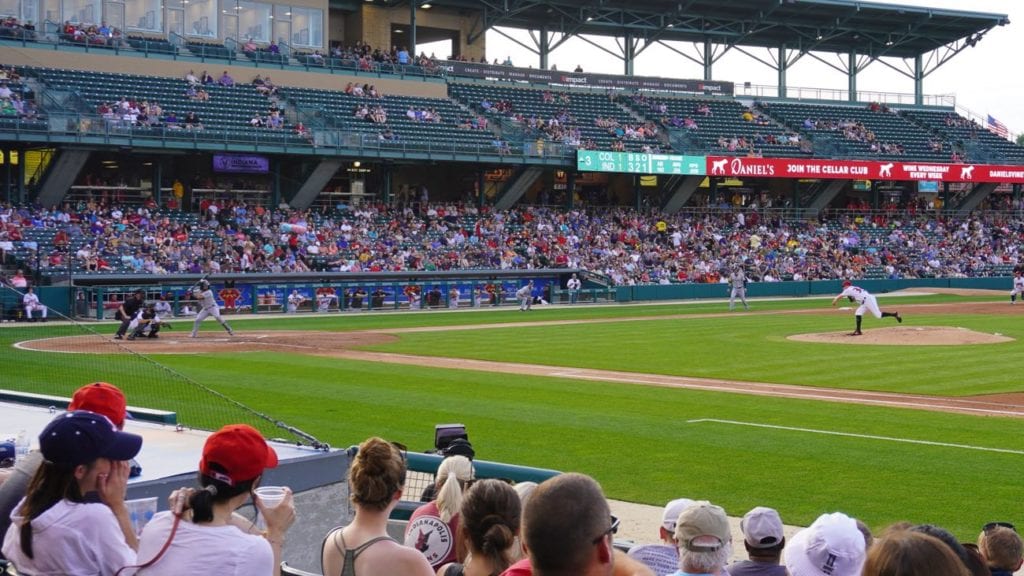
In short, the answer is easy: AS HARD AS POSSIBLE! As hard as the incredible hulk would throw it. As hard as you can, harder than your fastball.
Now what I’m referring to is intensity–you throw it of the mind that you’re throwing it 100% as hard as your fastball.
In doing this, your slider will come out typically about 8-10% slower than your fastball. In my book, I talk about the speed change ratios on all common pitches just like this one. It’s a great resource to keep learning.
- 100mph fastball = 90-92mph slider
- 90mph fastball = 81-83mph slider
- 80mph fastball = 72-74mph slider
- 70mph fastball = 62-64mph slider
- etc. etc.
If it’s slower than this, it’s not really a slider. If it’s harder than this, it’s not really a slider.
Basically, when you spin the pitch properly, it will end up in this velocity range because you lose velocity into the baseball when you spin it.
Spin basically absorbs velocity.
The more effort requires to spin the ball (such as with a curveball, which requires the fingers to reach further up the ball to apply topspin), the slower the pitch.
Because the slider is thrown with more energy forced through the center of the ball (as opposed to the curveball which requires more energy to go overtop of the ball) it can be thrown pretty hard relative to the fastball.
Curveballs are typically 13-20% slower than the fastball, though as hard as possible is also a rule on the curveball.
In summary: throw it as hard as you can, and the speed change should be 8-10% slower than your fastball speed.
How to Throw a Slider – the Learning Process
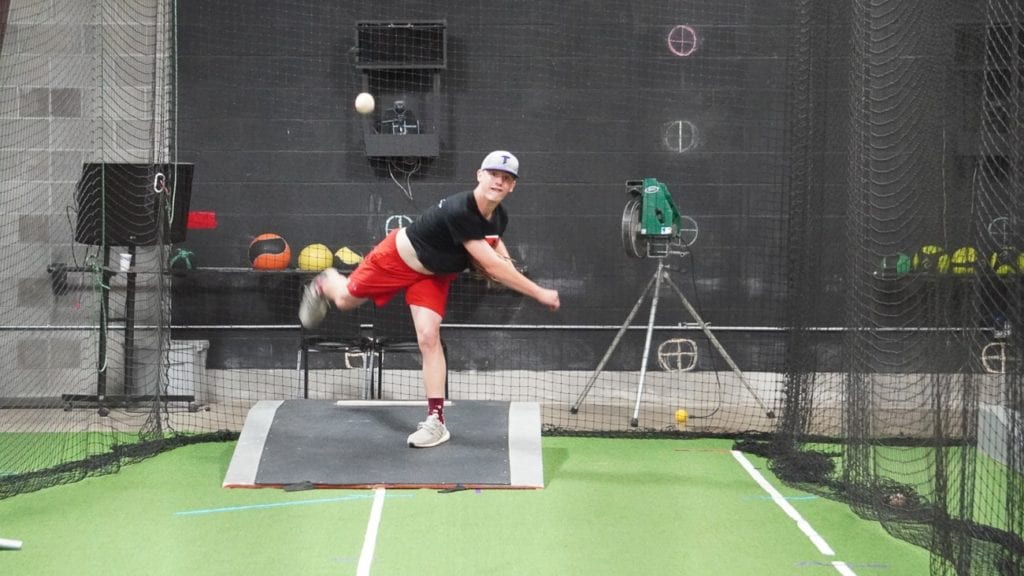
Basically, it goes like this:
- Find a grip you think might work for you
- Choose a pitching drill or two that allows you to focus more on your hand position than your full delivery
- Start 35-45 feet away from a partner
- Throw slow sliders using the pitching drill focusing just on spinning the ball properly and how it feels off your fingers
- Slowly move back, re-introduce your full mechanics and gradually add speed.
The #1 Throwing Drill You Should Use.
This drill, which I call the square-hips drill, is the best one to help isolate your hand position and feel the slider as you begin to learn. Start with this one in your learning progression!
Key Points to Remember When Learning a Slider
- The slower you throw it, the better you’ll get a feel for it. Fast = harder to tell if you’re doing it right.
- Slowly add speed and back up to full distance. The more you rush it, the less feel for the pitch you’ll develop.
- Drills serve to take some of your body out of the equation, making it easier to isolate and feel where your hand is in space.
- If your mechanics are bad, it’ll be harder to throw a good slider (or any pitch, for that matter)
- You have to throw it THOUSANDS OF TIMES before it becomes good. Stick with it and trust that it takes time. Let me repeat that:
You have to throw your new slider THOUSANDS OF TIMES before it becomes good. Stick with it and trust that it takes time.
Leave a Comment and Check Out My Pitching Resources
Thanks for reading! Here are ways to keep learning from me:
- My Books are great resources.
- My online courses are fantastic, like working with me in person.
- My email newsletter is beloved, a weekly sharing of my newest content.

Leave a comment and share this post with a friend!
Slide Grips & Tips FAQ
How do you grip a slider?

Put your index and middle fingers together, then place them on the inside of one of the seams on the horseshoe of the baseball. Overload the ball slightly toward the outside. You’ll throw the ball just as hard as your fastball, and the right slider grip helps you apply a mix of bullet spin and forward spin to make it break.
How does a slider move?
A slider breaks diagonally, usually 6-10 inches, though it may appear to break more the more slowly it’s thrown. The break always goes to the pitcher’s gloveside, which is away to a righty for a righthanded pitcher. The mixture of bullet spin and forward, angled spin is what creates the slider’s signature break and movement.
How do you throw a really good slider?
#1 is simple: practice it a ton by throwing it a lot while playing catch. Having a great catch partner and catcher is critical for giving you feedback on spinning the ball properly–you need someone to tell you when you throw a good one and when you throw a not-so-good one. The best pitchers who throw sliders have really fast arms and throw their sliders really hard–the harder its thrown, the more sudden the break will appear to a hitter. The grip matters as well, as some grips will work better for you in applying fast RPM, tight spin. Good sliders have high RPM spin but low spin efficiency, according to data from Rapsodo.
What age should you throw a slider?
The slider is stressful on the arm, but not necessarily more so than other pitches. The ASMI has proven through research that the fastball is the most stressful pitch in baseball, but for lots of reasons youth pitchers should still hold off on throwing breaking balls too early. Young pitchers who throw breaking balls–including sliders–report more arm pain than those who do not. The right age to start throwing a slider or curveball is between 14 and 15, which gives a player enough time to develop the pitch (takes 1-3 years) so that it’s good by the time the college recruiting process heats up. But, every pitcher is different so be careful and choose for yourself when the time is right.
What's the difference between a cutter and a slider?
A slider is thrown with a mixture of bullet spin and angled forward spin. A slider also is typically 10% slower than a fastball. Cutters, however, are thrown much harder with different spin. A cutter will be 4-6% slower than a fastball and has a tilted backspin that is slightly angled to the pitcher’s gloveside. Cutters break only a few inches whereas sliders break 6-10 inches.
Why is it called a slider?
Curveballs were the first breaking ball, and sliders came much later. They are named because of their shorter break and faster velocity. They appear to “slide away” from a hitter rather than taking this big, bending path that curveballs take.
